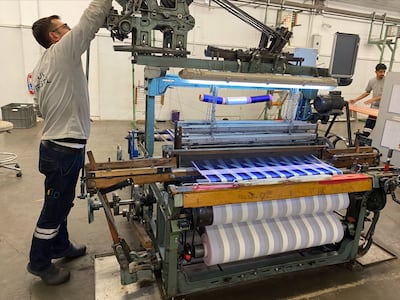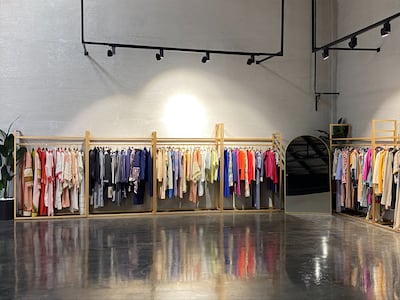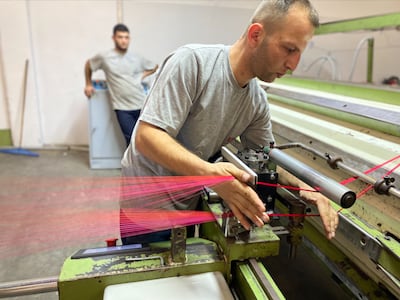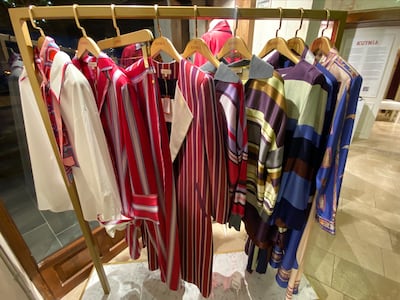Inside a factory at an industrial park, on the outskirts of Gaziantep in south-eastern Turkey, beautiful things are being made.
To the clack-clack of old wooden looms, striped fabrics in nutty browns and twinkling cobalt blue are coming to life. In one corner, their brows furrowed in concentration, workers funnel deep scarlet threads around a machine called a levent, preparing them for the loom.
The plant produces fabrics for Kutnia, a Turkish brand founded in the historical city of Gaziantep in 2017. The company is aiming to revive the production of “kutnu”, a fabric whose manufacture dates back to the 16th century, and which was traded across the former Ottoman Empire.
The word “kutnu” comes from the Arabic for “cotton” – “qutn” – a nod to the linguistic threads that weave fabrics and societies across this part of the world.
Facing competition from cheap imports and limitations imposed by the material’s traditional specifications, its production has long been in decline in Gaziantep, despite its central cultural importance.
According to Ottoman Touch, a London-based luxury brand selling items from and inspired by the former empire, kutnu was called “palace cloth” as it was used to make the sultans’ kaftans. There are more than 60 different types, depending on the number of warp yarns and motifs: Mecidiye, Hindiye, Zencirli, Sedefli, Cutari, Mercan, Sedyeli, Osmaniye, Sultan, and Mehtap are just a few.
Kutnia aims to revive kutnu fabric, which is seen in homes and shops as far away as Damascus and Baghdad – a sofa lining here, a striped waistcoat there. The firm, founded by a woman named Julide Konukoglu, started as a project with the local municipality in Gaziantep, before continuing as a private business.
“What she saw during this project was that so many designers tried to use kutnu in their designs, but they couldn't use it, because there were some problems in how it was done by hand – the width of the fabric was too narrow,” Zeynep Alti, Kutnia’s brand communication department director, told The National. “While keeping the DNA of how this fabric is made, we make the fabric wider, so that it is much more possible to make it into garments.”
Worker Hadil Bayel, 60, has been at Kutnia for seven years, and describes how the clacking sound of the wooden looms "is like a song to us," as it rings out against the walls. This production "is continuing our history,” he said.
Forty of the firm’s 100 employees are based in the city, which has been a manufacturing hub for centuries, thanks to its proximity to major trading routes – with the city of Aleppo, 120km away across the border in Syria, and Mediterranean Sea ports in neighbouring Hatay province.
Kutnia is now working with older “masters” who can teach production techniques to a younger generation of workers. They work on 12 handlooms and can produce 2,000 metres of fabric per month.
“Now at the factory we employ one of them who still teaches each step to weave to young generation masters,” Ms Alti said. Each weaver has a coloured tab on his loom to mark it as his own discretion.
Along with a greater width, Kutnia’s design and production teams have also modernised the fabric and designs for the 21st century. The material is now made using a combination of 40 per cent cotton and 60 per cent natural rayon in the warps, a more durable replacement for the traditionally used silk. New product lines incorporate autumn-winter and spring-summer ready-to-wear collections, covetable accessories such as delicate slippers, and upholstery fabrics.
Inspiration for colour palettes and the signature bold stripes is now taken from Gaziantep’s spice markets, overflowing with rich reds, pinks and oranges, and the white and black stone patterns, known as ablaq, that adorn the city’s khans – former market places – mosques and homes. The brand has two shops in Gaziantep, as well as a boutique in the upmarket shopping district of Nisantasi in Istanbul. In the Middle East, Kutnia products are available at Sauce and That Concept Store in Dubai, and Nass Boutique in Kuwait, and in Europe, at shops in Milan, Paris and London.
Customers, who hail from France and Lebanon among other places, can also apply to have custom-produced fabrics and patterns made.
“In the days of the Ottoman Empire, kutnu was sent as a gift to Europeans,” Ms Alti said. “You can even see this fabric in some of Matisse's paintings.” Current customers are mostly “curious travellers”, she added – people who appreciate the time and effort that goes into the production process, and who can afford the costs that entails: a blouse retails at 370 euros, a dress at 475 euros.
The items are high-quality and long-lasting, though. In a warehouse to one side of the factory, past collections line the walls: cornflower blue and white kaftans, bold ikat print jackets, and classic striped pyjamas in sweet shop pink palettes.
“When people are buying, they are really interested in how it is made – that it is still handmade, and it's very laborious. So people who appreciate these things, they buy the most, I would say,” she said.
FA CUP FINAL
Manchester City 6
(D Silva 26', Sterling 38', 81', 87', De Bruyne 61', Jesus 68')
Watford 0
Man of the match: Bernardo Silva (Manchester City)
Company%20Profile
%3Cp%3E%3Cstrong%3ECompany%20name%3A%20%3C%2Fstrong%3ENamara%0D%3Cbr%3E%3Cstrong%3EStarted%3A%20%3C%2Fstrong%3EJune%202022%0D%3Cbr%3E%3Cstrong%3EFounder%3A%20%3C%2Fstrong%3EMohammed%20Alnamara%0D%3Cbr%3E%3Cstrong%3EBased%3A%20%3C%2Fstrong%3EDubai%20%0D%3Cbr%3E%3Cstrong%3ESector%3A%20%3C%2Fstrong%3EMicrofinance%0D%3Cbr%3E%3Cstrong%3ECurrent%20number%20of%20staff%3A%20%3C%2Fstrong%3E16%0D%3Cbr%3E%3Cstrong%3EInvestment%20stage%3A%20%3C%2Fstrong%3ESeries%20A%0D%3Cbr%3E%3Cstrong%3EInvestors%3A%20%3C%2Fstrong%3EFamily%20offices%0D%3Cbr%3E%3C%2Fp%3E%0A
Herc's Adventures
Developer: Big Ape Productions
Publisher: LucasArts
Console: PlayStation 1 & 5, Sega Saturn
Rating: 4/5
Jewel of the Expo 2020
252 projectors installed on Al Wasl dome
13.6km of steel used in the structure that makes it equal in length to 16 Burj Khalifas
550 tonnes of moulded steel were raised last year to cap the dome
724,000 cubic metres is the space it encloses
Stands taller than the leaning tower of Pisa
Steel trellis dome is one of the largest single structures on site
The size of 16 tennis courts and weighs as much as 500 elephants
Al Wasl means connection in Arabic
World’s largest 360-degree projection surface
Why seagrass matters
- Carbon sink: Seagrass sequesters carbon up to 35X faster than tropical rainforests
- Marine nursery: Crucial habitat for juvenile fish, crustations, and invertebrates
- Biodiversity: Support species like sea turtles, dugongs, and seabirds
- Coastal protection: Reduce erosion and improve water quality
ALRAWABI%20SCHOOL%20FOR%20GIRLS
%3Cp%3ECreator%3A%20Tima%20Shomali%3C%2Fp%3E%0A%3Cp%3EStarring%3A%C2%A0Tara%20Abboud%2C%C2%A0Kira%20Yaghnam%2C%20Tara%20Atalla%3C%2Fp%3E%0A%3Cp%3ERating%3A%204%2F5%3C%2Fp%3E%0A
Pharaoh's curse
British aristocrat Lord Carnarvon, who funded the expedition to find the Tutankhamun tomb, died in a Cairo hotel four months after the crypt was opened.
He had been in poor health for many years after a car crash, and a mosquito bite made worse by a shaving cut led to blood poisoning and pneumonia.
Reports at the time said Lord Carnarvon suffered from “pain as the inflammation affected the nasal passages and eyes”.
Decades later, scientists contended he had died of aspergillosis after inhaling spores of the fungus aspergillus in the tomb, which can lie dormant for months. The fact several others who entered were also found dead withiin a short time led to the myth of the curse.
Islamophobia definition
A widely accepted definition was made by the All Party Parliamentary Group on British Muslims in 2019: “Islamophobia is rooted in racism and is a type of racism that targets expressions of Muslimness or perceived Muslimness.” It further defines it as “inciting hatred or violence against Muslims”.
The five pillars of Islam
The specs: 2018 Nissan Altima
Price, base / as tested: Dh78,000 / Dh97,650
Engine: 2.5-litre in-line four-cylinder
Power: 182hp @ 6,000rpm
Torque: 244Nm @ 4,000rpm
Transmission: Continuously variable tranmission
Fuel consumption, combined: 7.6L / 100km
COMPANY PROFILE
Founders: Alhaan Ahmed, Alyina Ahmed and Maximo Tettamanzi
Total funding: Self funded
The five pillars of Islam
1. Fasting
2. Prayer
3. Hajj
4. Shahada
5. Zakat
How to wear a kandura
Dos
- Wear the right fabric for the right season and occasion
- Always ask for the dress code if you don’t know
- Wear a white kandura, white ghutra / shemagh (headwear) and black shoes for work
- Wear 100 per cent cotton under the kandura as most fabrics are polyester
Don’ts
- Wear hamdania for work, always wear a ghutra and agal
- Buy a kandura only based on how it feels; ask questions about the fabric and understand what you are buying
ZAYED SUSTAINABILITY PRIZE
The Voice of Hind Rajab
Starring: Saja Kilani, Clara Khoury, Motaz Malhees
Director: Kaouther Ben Hania
Rating: 4/5
WHEN TO GO:
September to November or March to May; this is when visitors are most likely to see what they’ve come for.
WHERE TO STAY:
Meghauli Serai, A Taj Safari - Chitwan National Park resort (tajhotels.com) is a one-hour drive from Bharatpur Airport with stays costing from Dh1,396 per night, including taxes and breakfast. Return airport transfers cost from Dh661.
HOW TO GET THERE:
Etihad Airways regularly flies from Abu Dhabi to Kathmandu from around Dh1,500 per person return, including taxes. Buddha Air (buddhaair.com) and Yeti Airlines (yetiairlines.com) fly from Kathmandu to Bharatpur several times a day from about Dh660 return and the flight takes just 20 minutes. Driving is possible but the roads are hilly which means it will take you five or six hours to travel 148 kilometres.
Lexus LX700h specs
Engine: 3.4-litre twin-turbo V6 plus supplementary electric motor
Power: 464hp at 5,200rpm
Torque: 790Nm from 2,000-3,600rpm
Transmission: 10-speed auto
Fuel consumption: 11.7L/100km
On sale: Now
Price: From Dh590,000
Specs
Engine: 51.5kW electric motor
Range: 400km
Power: 134bhp
Torque: 175Nm
Price: From Dh98,800
Available: Now
Safety 'top priority' for rival hyperloop company
The chief operating officer of Hyperloop Transportation Technologies, Andres de Leon, said his company's hyperloop technology is “ready” and safe.
He said the company prioritised safety throughout its development and, last year, Munich Re, one of the world's largest reinsurance companies, announced it was ready to insure their technology.
“Our levitation, propulsion, and vacuum technology have all been developed [...] over several decades and have been deployed and tested at full scale,” he said in a statement to The National.
“Only once the system has been certified and approved will it move people,” he said.
HyperloopTT has begun designing and engineering processes for its Abu Dhabi projects and hopes to break ground soon.
With no delivery date yet announced, Mr de Leon said timelines had to be considered carefully, as government approval, permits, and regulations could create necessary delays.
Auron Mein Kahan Dum Tha
Starring: Ajay Devgn, Tabu, Shantanu Maheshwari, Jimmy Shergill, Saiee Manjrekar
Director: Neeraj Pandey
Rating: 2.5/5
Williams at Wimbledon
Venus Williams - 5 titles (2000, 2001, 2005, 2007 and 2008)
Serena Williams - 7 titles (2002, 2003, 2009, 2010, 2012, 2015 and 2016)






